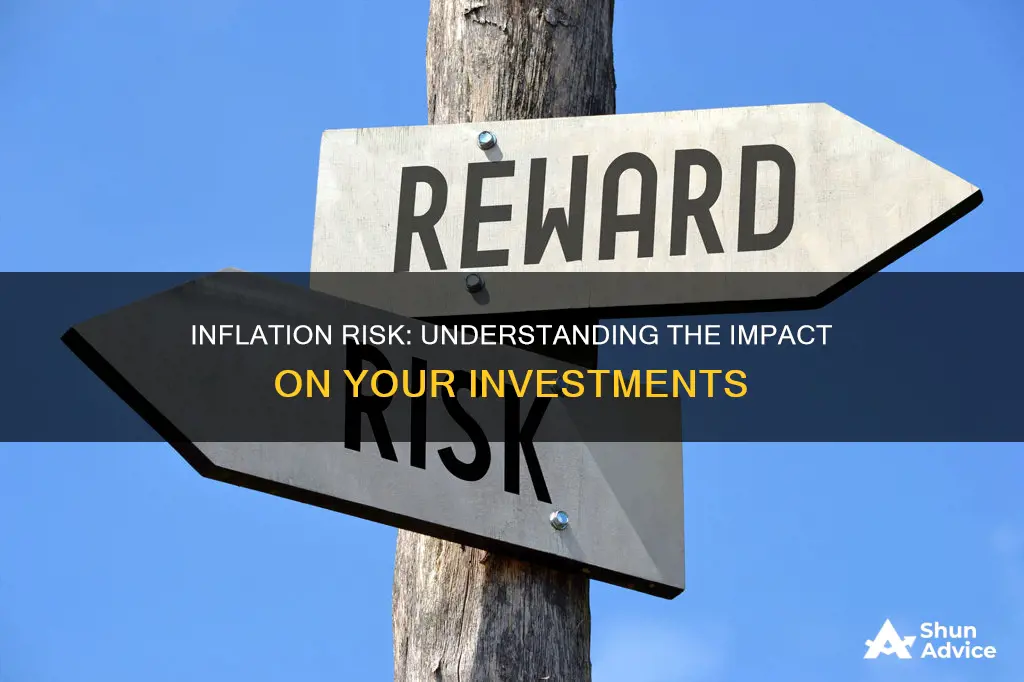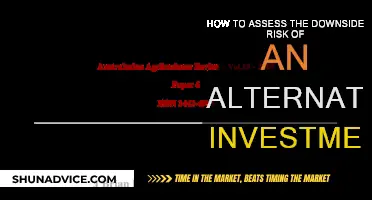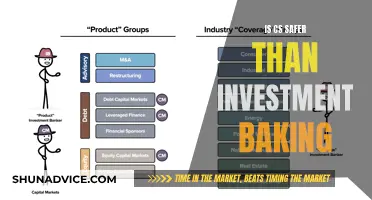
Inflation risk is the risk that inflation will undermine the performance of an investment, the value of an asset, or the purchasing power of a stream of income. In other words, it's the risk that inflation will erode an investment's returns through a drop in purchasing power. Inflation risk can impact all investments, whether cash, bonds, equities, or other asset classes.
| Characteristics | Values |
|---|---|
| Definition | The risk that inflation will erode an investment's returns through a drop in purchasing power |
| Impact | Inflation risk can impact all investments, including cash, bonds, equities, or other asset classes |
| Example | If an investor buys a 30-year bond that pays a four per cent interest rate, but inflation skyrockets to 12%, the investor is in serious trouble |
| Most vulnerable investments | Bonds are considered most vulnerable to inflationary risk |
What You'll Learn

The nominal rate of return vs the real rate of return
Inflation risk refers to the possibility that inflation will reduce the value of an investment, asset, or income stream. In other words, it is the risk that inflation will erode an investment's returns through a drop in purchasing power. For example, if prices increase but income remains the same, the purchasing power of money falls.
When it comes to investing, it is important to understand the difference between the nominal rate of return and the real rate of return. The nominal rate of return is your investment return without factoring in inflation. This means that the nominal rate of return can be misleading, as it does not take into account the impact of inflation on the value of your investment. On the other hand, the real rate of return considers inflation. It is your investment return minus the inflation rate, which gives you the purchasing power of your investment. In times of high inflation, the real rate of return is what matters most. This is because the nominal rate of return can be high, but if inflation is higher, the real value of your investment may be reduced.
For example, let's say you invest in a bond that pays a fixed interest rate of 4% per year. If inflation is 2%, your real rate of return is only 2% (4% - 2% = 2%). This means that the purchasing power of your investment is only increasing by 2% per year. If inflation were to increase to 6%, your real rate of return would be negative (-2% - 6% = -8%). This would mean that the purchasing power of your investment is decreasing, and you would be losing money in real terms.
Bonds are considered particularly vulnerable to inflation risk because their payouts are generally based on fixed interest rates. This means that an increase in inflation diminishes their purchasing power. However, other types of investments, such as equities and cash, can also be impacted by inflation risk. It is important for investors to consider the potential impact of inflation when making investment decisions and to diversify their portfolios to mitigate this risk.
Understanding Investment Risks: What Could Go Wrong?
You may want to see also

Inflation's impact on different investment types
Inflation risk refers to the risk that inflation will undermine the performance of an investment, the value of an asset, or the purchasing power of a stream of income. In other words, it is the risk that inflation will erode an investment's returns through a drop in purchasing power.
Inflation risk can impact all investment types, including cash, bonds, equities, and other asset classes. However, bonds are considered the most vulnerable to inflationary risk. This is because bond payments are generally based on fixed interest rates, meaning an increase in inflation diminishes their purchasing power. For example, if an investor buys a 30-year bond that pays a four per cent interest rate, but inflation skyrockets to 12%, the investor is in serious trouble. With each passing year, the bondholder loses more and more purchasing power, regardless of how safe they feel the investment is.
Equities are also impacted by inflation risk, as higher inflation can lead to increased costs for companies, which may result in lower profits and, consequently, lower stock prices.
Cash investments are not immune to inflation risk either. As inflation rises, the purchasing power of cash decreases. This means that the value of a cash investment today will be worth less in the future due to inflation.
Other asset classes, such as real estate, commodities, and collectibles, can also be affected by inflation risk. For example, rising inflation can lead to higher property prices, which may impact the affordability and demand for real estate investments.
Overall, inflation risk is a significant consideration for investors, as it can erode the returns and value of their investments over time. It is important for investors to understand the potential impact of inflation on different investment types and to consider strategies to mitigate this risk, such as investing in assets that have the potential to keep pace with or outperform inflation.
International Equity: Worth the Investment Risk?
You may want to see also

Inflationary risk and bonds
Inflation risk refers to the risk that inflation will undermine the performance of an investment, the value of an asset, or the purchasing power of a stream of income. In other words, it is the risk that inflation will erode an investment's returns through a drop in purchasing power.
Bonds are considered to be the most vulnerable to inflationary risk. Bond payments are generally based on fixed interest rates, meaning that an increase in inflation diminishes their purchasing power. For example, if an investor buys a 30-year bond that pays a four per cent interest rate, but inflation skyrockets to 12 per cent, the investor is in serious trouble. With each passing year, the bondholder loses more and more purchasing power, regardless of how safe they feel the investment is.
The impact of inflationary risk on bonds can be mitigated by investing in bonds with variable interest rates or by investing in other asset classes that are less vulnerable to inflation, such as equities or real estate.
Inflationary risk can also be mitigated by investing in financial instruments that are designed to counteract inflationary risks, such as inflation-linked bonds or commodities. Inflation-linked bonds are bonds that have their principal value adjusted based on the inflation rate, which helps to protect investors from the negative impact of inflation. Commodities, such as gold or other precious metals, can also be used to hedge against inflation as they tend to hold their value or even increase in value during periods of high inflation.
Overall, while bonds are vulnerable to inflationary risk, there are strategies that investors can use to mitigate this risk and protect their investments. By understanding the potential impact of inflation on their bond holdings and taking appropriate action, investors can help ensure that their investments remain sound and continue to generate positive returns over the long term.
Creating Pet Toys: A Guide to Investing and Making
You may want to see also

Counteracting inflationary risk
Inflation risk refers to the possibility that inflation will undermine the performance of an investment, the value of an asset, or the purchasing power of a stream of income. In other words, it is the risk that the future real value (after inflation) of an investment, asset, or income stream will be reduced by unanticipated inflation.
To counteract inflationary risk, investors can consider the following strategies:
- Diversify your investment portfolio: Spread your investments across different asset classes, such as stocks, bonds, real estate, and commodities. Diversification can help reduce the impact of inflation on any single investment and protect your overall portfolio.
- Invest in inflation-protected securities: These are financial instruments specifically designed to protect against inflation. Examples include Treasury Inflation-Protected Securities (TIPS) in the US, which adjust their principal value based on the inflation rate.
- Focus on assets with pricing power: Invest in companies or assets that have the ability to pass on increased costs to their customers. This can include companies with strong brands, market dominance, or pricing flexibility.
- Consider real assets: Invest in real assets such as commodities, real estate, or infrastructure, which tend to hold their value during inflationary periods. Commodities, in particular, can serve as a hedge against inflation as their prices often rise with inflation.
- Monitor and adjust your portfolio: Stay informed about economic conditions and inflationary trends. Regularly review and rebalance your investment portfolio to ensure it aligns with your risk tolerance and investment goals. This may involve adjusting your asset allocation or taking profits to protect your purchasing power.
By implementing these strategies, investors can better protect their portfolios from the negative effects of inflation and preserve the purchasing power of their investments over time.
Beneficial Investments: Strategies for Smart Money Allocation
You may want to see also

Inflation and the purchasing power of money
Inflation risk is the risk that inflation will reduce the value of an investment, asset or income stream. Inflation is the rise in the price of goods and services over time. If prices increase and income remains fixed, the purchasing power of money falls.
For investors, inflation risk is the risk that inflation will erode an investment's returns through a drop in purchasing power. Investment returns can be measured in two ways: the nominal rate of return is the investment return without factoring in inflation, while the real rate of return considers inflation. It is the investment return minus the inflation rate, which gives you the purchasing power of your investment. In times of inflation, your real rate of return matters most.
Bonds are considered the most vulnerable to inflation risk. Most bonds receive a fixed coupon rate that doesn't increase. Therefore, if an investor buys a 30-year bond that pays a four per cent interest rate, but inflation skyrockets to 12 per cent, the investor is in serious trouble. With each passing year, the bondholder loses more and more purchasing power, regardless of how safe they feel the investment is.
Inflation can be good news for investors if it is moderate, as it can indicate an expanding economy, one with job growth and increasing wages. However, when inflation is high, it can be tricky for investors. A May survey by BlackRock Fundamental Equities found that 62% of investors viewed inflation as the biggest threat to the US stock market over the next six months.
A Guide to Investing in Paytm: What Indians Need to Know
You may want to see also
Frequently asked questions
Inflation risk is the risk that inflation will reduce the value of an investment, asset or income stream.
Inflation can erode an investment's returns through a drop in purchasing power. For example, if an investor buys a 30-year bond that pays a four per cent interest rate, but inflation skyrockets to 12 per cent, the investor is in serious trouble.
The nominal rate of return is your investment return without factoring in inflation. The real rate of return considers inflation and gives you the purchasing power of your investment.
Bonds are considered most vulnerable to inflation risk because their payouts are generally based on fixed interest rates, meaning an increase in inflation diminishes their purchasing power.







